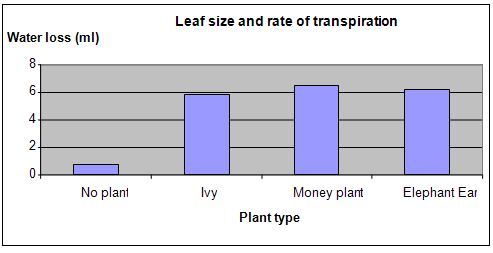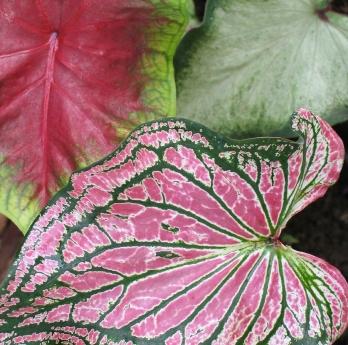| Complexity level: | 6 |
| Project cost ($): | 25 |
| Time required: | 1 hour to prepare, 5 days for the science project experiment |
| Material availability: | Plants may be purchased at a plant nursery. |
| Safety concerns: | Basic safety requirements |
Hypothesis
Plants with big leaves have more stomata and lose more water through transpiration.
Overview
Transpiration
Transpiration in plants will cause water to be lost from the surface of the leaves, stems, flowers and fruits. The amount of water that is lost from plants through transpiration will depend on the size of the plant, the temperature of the plant, the humidity, amount of light received, wind and the amount of water in the soil.
The leaves of a plant contain a lot of stomata. These stomata consist of a hole called the stoma and guard cells at the sides. The opening in the stomata is used for gas exchange to take place. While some plant species have stomata on both sides of the leaf, most plants only have them at the bottom side of the leaf. The guard cells are used to open and close the stoma. When the stoma is open, carbon dioxide molecules will enter and be used in the photosynthesis process. However, water will also escape from the stoma when it is open.
When the diffusion of water molecules from the leaf surface occurs, the hydrostatic pressure in the upper parts of the plant will be reduced. This will cause water from the roots to flow upwards and carry nutrients from the soil. The flow of water will also help to cool the plants.
Scientific Terms
Materials
- The graph below represents the results of our science project experiment:4 large beakers
- 1 measuring cylinder
- Tap water
- 1 ivy plant
- 1 money plant
- 1 elephant ear plant
(The size of the ivy plant, money plant and elephant plant should be almost same)
Procedure
1. For this science project, the independent variable is the type of plant used – the ivy (Hedera), money plant (Epipremnum aureum) and elephant ear plant (a member of the Caladium family). The dependent variable is the amount of water lost from the beaker through evaporation and transpiration. This is determined by using the measuring cylinder to measure the water after 5 days. The constants (control variables) are the size of the plants, the size of the beaker, the amount of water in the beaker, the room temperature, wind in the room and the amount of sunlight received by the plants.
2. The ivy, money plant and elephant ear plant are removed from the soil and the roots are washed under the tap water to remove all the soil and dirt.
3. Four beakers are filled with 100ml of tap water each. The water is measured using the measuring cylinder. The 3 plants are placed inside each of the beakers. The fourth beaker will be the control without any plant.
4. The 4 beakers are placed in a location where they will receive the same amount of sunlight. The plants will be observed for 5 days. On the fifth day, the amount of water remaining in the beakers is measured using the measuring cylinder. The amount of water lost through transpiration and evaporation is recorded in the table given below.

Results
It was observed that there was no significant difference in the amount of water lost from each the beakers that contained the 3 types different of plants respectively.
|
Plant type |
Amount of water lost through transpiration |
|||
|
No plant |
Ivy |
Money plant |
Elephant Ear |
|
|
Water lost (ml) |
0.75 |
5.85 |
6.55 |
6.20 |
The chart below represents the results of our science project experiment:

Conclusion
The hypothesis that plants with big leaves have more stomata and lose more water through transpiration is proven to be false. All plants had almost the same rate of water loss over the 5 days. The small ivy plant had more leaves and the big elephant ear plant had less leaves. Therefore the total number of stomata might have been similar.
Evapo-transpiration is the total loss of water from the surface of the earth into the atmosphere. It consists of the water evaporating from the soil and water bodies and also the transpiration of water that occurs in plants. These processes are part of the water cycle.
Also consider
Try to repeat the experiment using more varieties of plants, or by using just 1 plant variety (eg. elephant ear plant) but varying the number of leaves.
The experiment can also be repeated by calculating the surface area of the leaves and comparing the difference in results.
References
Plant transpiration - http://www.juliantrubin.com/encyclopedia/botany/transpiration.html
Stoma - http://en.wikipedia.org/wiki/Stoma

